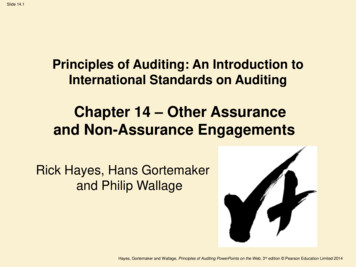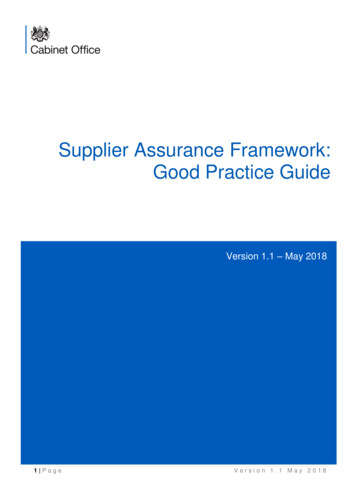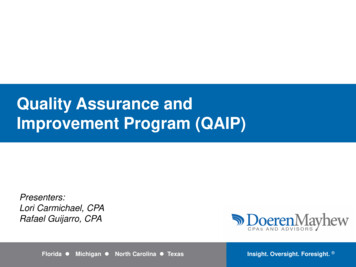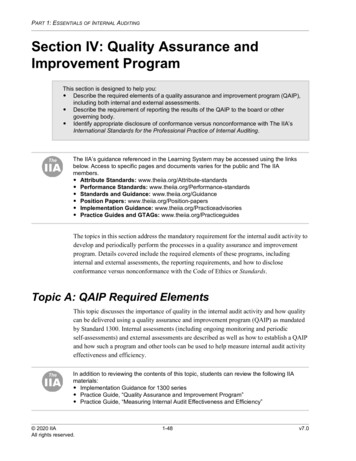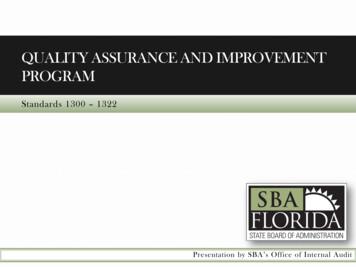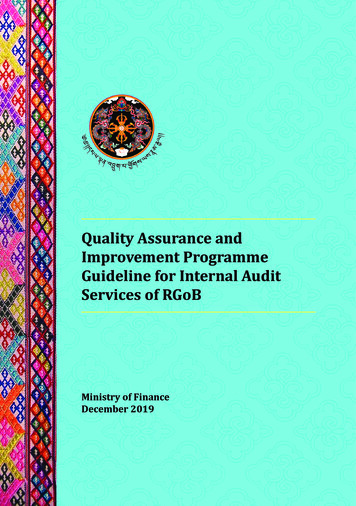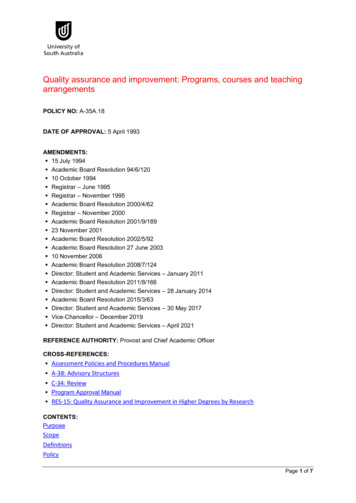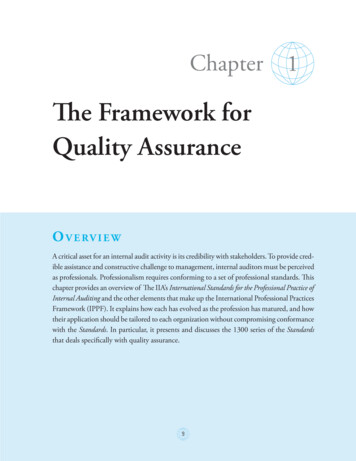
Transcription
Chapter1The Framework forQuality AssuranceO v e rv i e wA critical asset for an internal audit activity is its credibility with stakeholders. To provide credible assistance and constructive challenge to management, internal auditors must be perceivedas professionals. Professionalism requires conforming to a set of professional standards. Thischapter provides an overview of The IIA’s International Standards for the Professional Practice ofInternal Auditing and the other elements that make up the International Professional PracticesFramework (IPPF). It explains how each has evolved as the profession has matured, and howtheir application should be tailored to each organization without compromising conformancewith the Standards. In particular, it presents and discusses the 1300 series of the Standardsthat deals specifically with quality assurance.9
S ta n d a r d s R e q u i r e Q ua l i t yAssurance FocusChief audit executives (CAEs) need assurance that their internal audit activity and each memberof their staff conform to all mandatory elements of the IPPF, and they need to demonstratethis conformance to their stakeholders. The only way to meet these expectations is with acomprehensive quality assurance and improvement program (QAIP) that includes ongoingmonitoring of performance, periodic internal assessments, external assessments conductedby a qualified, independent assessor or assessment team from outside the organization, andcommunication of the results.Standards and Other Professional Guidance Have EvolvedWith the Profession10The steadily expanding scope and global reach of internal auditing is reflected in and fosteredby changes in the Standards and professional guidance. Changes occurred in the Standardseffective January 1, 2017, and contribute to the update to this manual. A significant changein professional guidance occurred in 1999 with a new Definition of Internal Auditing andthe development of the Professional Practices Framework, which became the IPPF in 2009.The IPPF was further updated and expanded in July 2015, and again in 2017. Evaluatingrisk management and governance processes is much more challenging and meaningful thancontrol alone. It requires internal audit to operate at a higher, more strategic level. To operateat this level, internal auditors need a higher level of credibility with their stakeholders.Quality Assurance Has Evolved With the StandardsThe original Standards (1978) stated, “The director of internal auditing should establish andmaintain a quality assurance program” that includes an external quality assessment (EQA)every three years. The three-year time frame was chosen to be in line with guidance from theU.S. Government Accountability Office (U.S. GAO). In the 2002 revision of the Standards,The IIA changed the time frame to every five years, as this was considered more appropriatefor an internal audit activity.Quality Assessment Manual for the Internal Audit Activity
T h e IPP FThe requirements and characteristics of quality in an internal audit activity are defined bythe IPPF, which consists of mandatory and recommended guidance, all provided within thecontext of the Mission of Internal Audit as defined in the IPPF.Mandatory GuidanceMandatory guidance is considered essential for the professional practice of internal auditing.Mandatory guidance is submitted for review by the entire global profession through the exposure draft process. It consists of four elements: Core Principles: The Core Principles for the Professional Practice of InternalAuditing are the foundation for the IPPF and support internal audit effectiveness. Definition of Internal Auditing: “Internal auditing is an independent, objective assurance and consulting activity designed to add value and improve anorganization’s operations. It helps an organization accomplish its objectives bybringing a systematic, disciplined approach to evaluate and improve the effectiveness of risk management, control, and governance processes.” Code of Ethics: The Principles and Rules of Conduct of the Code of Ethicsdefine ethical behavior for a professional internal auditor.Chapter 1 The Framework for Quality Assurance11
Standards: The Standards are the central criteria that define the attributesand characteristics of performance for an internal audit activity, including therequirements for a QAIP.Recommended GuidanceRecommended guidance is endorsed by The IIA through a formal approval process. Itdescribes practices for the effective implementation of the Core Principles, the Definitionof Internal Auditing, the Code of Ethics, and the Standards. Recommended guidance helpsinternal auditors understand and apply the Standards and may provide insight into goingbeyond conformance to a higher level of adding value, or addressing issues of concern notrelated to a specific standard. Recommended guidance is described in terms of implementation guidance and supplemental guidance and is available to IIA members on The IIA’swebsites: global.theiia.org and na.theiia.org. Implementation Guidance: Implementation Guides exist for each standard.They are intended to provide guidance to internal audit practitioners withregard to conformance with the Standards. Supplemental Guidance: Supplemental guidance provides detailed guidance for conducting internal audit activities. Supplemental guidance includestopical areas, sector-specific issues, as well as processes and procedures, toolsand techniques, programs, step-by-step approaches, and examples of deliverables. Examples of supplemental guidance currently include Practice Guides,Global Technology Audit Guides (GTAGs), and Guides to the Assessment ofIT Risk (GAIT).12Quality Assurance and Improvement ProgramStandard 1300 – Quality Assurance and Improvement Program is included in full because itdefines the requirements for a QAIP. Consult The IIA’s website for the most current versionof the Standards and for recommended guidance. Chapter 2 of this manual describes therequirements and considerations for establishing a QAIP. Chapters 3, 4, and 5 describe therequirements and considerations for performing internal assessments, a full external assessment, and a self-assessment with independent validation, respectively.Quality Assessment Manual for the Internal Audit Activity
1300 – Quality Assurance and Improvement ProgramThe chief audit executive must develop and maintain a quality assurance and improvementprogram that covers all aspects of the internal audit activity.Interpretation:A quality assurance and improvement program is designed to enable an evaluation of the internalaudit activity’s conformance with the Standards and an evaluation of whether internal auditorsapply the Code of Ethics. The program also assesses the efficiency and effectiveness of the internalaudit activity and identifies opportunities for improvement. The chief audit executive shouldencourage board oversight in the quality assurance and improvement program.1310 – Requirements of the Quality Assurance and ImprovementProgramThe quality assurance and improvement program must include both internal and externalassessments.131311 – Internal AssessmentsInternal assessments must include: Ongoing monitoring of the performance of the internal audit activity. Periodic self-assessments or assessments by other persons within the organization with sufficient knowledge of internal audit practices.Interpretation:Ongoing monitoring is an integral part of the day-to-day supervision, review, and measurement ofthe internal audit activity. Ongoing monitoring is incorporated into the routine policies and practices used to manage the internal audit activity and uses processes, tools, and information considerednecessary to evaluate conformance with the Code of Ethics and the Standards.Periodic assessments are conducted to evaluate conformance with the Code of Ethics and theStandards.Chapter 1 The Framework for Quality Assurance
Sufficient knowledge of internal audit practices requires at least an understanding of all elementsof the International Professional Practices Framework.1312 – External AssessmentsExternal assessments must be conducted at least once every five years by a qualified, independent assessor or assessment team from outside the organization. The chief audit executivemust discuss with the board: The form and frequency of external assessment. The qualifications and independence of the external assessor or assessmentteam, including any potential conflict of interest.Interpretation:14External assessments may be accomplished through a full external assessment, or a self-assessmentwith independent external validation. The external assessor must conclude as to conformance withthe Code of Ethics and the Standards; the external assessment may also include operational or strategic comments.A qualified assessor or assessment team demonstrates competence in two areas: the professional practice of internal auditing and the external assessment process. Competence can be demonstratedthrough a mixture of experience and theoretical learning. Experience gained in organizations ofsimilar size, complexity, sector or industry, and technical issues is more valuable than less relevantexperience. In the case of an assessment team, not all members of the team need to have all thecompetencies; it is the team as a whole that is qualified. The chief audit executive uses professionaljudgment when assessing whether an assessor or assessment team demonstrates sufficient competence to be qualified.An independent assessor or assessment team means not having an actual or perceived conflict ofinterest and not being a part of, or under the control of, the organization to which the internalaudit activity belongs. The chief audit executive should encourage board oversight in the externalassessment to reduce perceived or potential conflicts of interest.Quality Assessment Manual for the Internal Audit Activity
1320 – Reporting on the Quality Assurance and ImprovementProgramThe chief audit executive must communicate the results of the quality assurance and improvement program to senior management and the board. Disclosure should include: The scope and frequency of both the internal and external assessments. The qualifications and independence of the assessor(s) or assessment team,including potential conflicts of interest. Conclusions of assessors. Corrective action plans.Interpretation:The form, content, and frequency of communicating the results of the quality assurance and improvement program is established through discussions with senior management and the board andconsiders the responsibilities of the internal audit activity and chief audit executive as contained inthe internal audit charter. To demonstrate conformance with the Code of Ethics and the Standards,the results of external and periodic internal assessments are communicated upon completion of suchassessments and the results of ongoing monitoring are communicated at least annually. The resultsinclude the assessor’s or assessment team’s assessment with respect to the degree of conformance.1321 – Use of “Conforms with the International Standards for theProfessional Practice of Internal Auditing”Indicating that the internal audit activity conforms with the International Standards for theProfessional Practice of Internal Auditing is appropriate only if supported by the results of thequality assurance and improvement program.Interpretation:The internal audit activity conforms with the Code of Ethics and the Standards when it achievesthe outcomes described therein. The results of the quality assurance and improvement programinclude the results of both internal and external assessments. All internal audit activities will haveChapter 1 The Framework for Quality Assurance15
the results of internal assessments. Internal audit activities in existence for at least five years willalso have the results of external assessments.1322 – Disclosure of NonconformanceWhen nonconformance with the Code of Ethics or the Standards impacts the overall scopeor operation of the internal audit activity, the chief audit executive must disclose the nonconformance and the impact to senior management and the board.A p p l i ca t i o n16of theIPP FThe IPPF is the foundation of quality for an internal audit activity. While it is equally applicableto all internal audit activities, the actual practice of internal auditing within an organizationmust be adapted to such factors as an organization’s legal, regulatory, and cultural environment, and industry, size, and stakeholder expectations. The CAE must adapt internal auditingto the organization’s environment while still conforming with the Standards. Assessors shouldconsider this adaptation.Internal auditing may be less mature in emerging countries, privately held (not listed) companies, not-for-profit organizations, small companies, and organizations with a relatively newinternal audit activity. At the same time, many mature internal audit activities that are generally in conformance with the Standards and the Code of Ethics look for ways to providecontext to the operation of their activity. Maturity models are used in some of these organizations to provide this context. Examples of maturity models are available on the internetand can be adapted by an organization to provide additional insight into maturity levels forspecific internal audit processes or elements of infrastructure.Quality Assessment Manual for the Internal Audit Activity
A quality assurance and improvement program is designed to enable an evaluation of the internal audit activity’s conformance with the Standards and an evaluation of whether internal auditors apply the Code of Ethics. The program also assesses the efficiency and effectiveness of the internalFile Size: 214KBPage Count: 8





